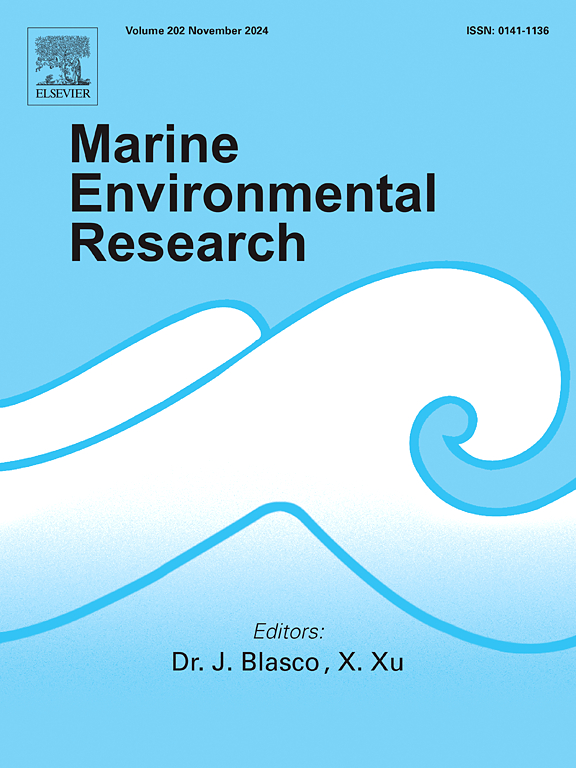相模海深槽夏季侧向氮输入增强了颗粒有机碳输出
IF 3
3区 环境科学与生态学
Q2 ENVIRONMENTAL SCIENCES
引用次数: 0
摘要
在与开阔海洋相连的深海湾中,有效的碳固存是通过在透光区产生的有机微粒的下沉来实现的。温带海湾表层的营养条件对颗粒的产生至关重要,除了来自下面的季节性混合外,还受到寡营养开放水和含有陆地营养物质的淡水的横向流入的影响。本研究通过2007-2008年的8次重复观测,研究了东京湾以南相模海表层悬浮颗粒氮(PN)同位素三角洲(δ15N)的变化,以研究海底深度超过1500 m的相模海上层PN和营养动态。δ15NPN表现出冬季低、夏季高的季节变化特征,但其在夏季的水平分布与盐度的显著变化密切相关,并与PN浓度密切相关。采用以近海水和低盐度水为端元的保守混合模型对相模海负δ 15npn -盐度关系进行分析,发现东京湾的淡水流入向相模海提供了高δ15N的N。这平均贡献了相模海沿海水域夏季悬浮PN的74%。暴雨事件后,该N输入的运输效率增加,极大地刺激了海湾的夏季生产力。因此,夏季氮输入可能在向中上层输出颗粒有机碳和吸收大气二氧化碳方面发挥重要作用。本文章由计算机程序翻译,如有差异,请以英文原文为准。

Lateral nitrogen input during summer in Sagami Sea with a deep trough enhances particulate organic carbon export
In deep bays linked to the open ocean, efficient carbon sequestration occurs through the sinking of particulate organic matter produced in the euphotic zone. Nutrient conditions in the surface layer of temperate bays, which are crucial for particle production, are influenced by the lateral inflows of oligotrophic open water and freshwater containing terrestrial nutrients, in addition to seasonal mixing from below. This study, conducted through eight repeated observations in 2007–2008, investigated variations in surface water suspended particulate nitrogen (PN) isotope delta (δ15N) to examine upper layer PN and nutrient dynamics in Sagami Sea, located south of Tokyo Bay, with a seafloor depth exceeding 1500 m. While δ15NPN showed seasonal variations, such as low in winter and high in summer, its horizontal distribution in summer closely correlated with a significant salinity variation, alongside PN concentration. Analysis of the negative δ15NPN-salinity relationship, using a conservative mixing model with the offshore water and the low-salinity water as endmembers, revealed that N with a high δ15N was supplied to Sagami Sea through freshwater inflow from Tokyo Bay. This contributed on average 74 % of the summer suspended PN in coastal waters in Sagami Sea. The transport efficiency of this N input increases after heavy rain events, which greatly stimulates summer productivity in the bay. Consequently, summer N inputs may play a vital role in exporting particulate organic carbon to the mesopelagic zone and absorbing atmospheric carbon dioxide.
求助全文
通过发布文献求助,成功后即可免费获取论文全文。
去求助
来源期刊

Marine environmental research
环境科学-毒理学
CiteScore
5.90
自引率
3.00%
发文量
217
审稿时长
46 days
期刊介绍:
Marine Environmental Research publishes original research papers on chemical, physical, and biological interactions in the oceans and coastal waters. The journal serves as a forum for new information on biology, chemistry, and toxicology and syntheses that advance understanding of marine environmental processes.
Submission of multidisciplinary studies is encouraged. Studies that utilize experimental approaches to clarify the roles of anthropogenic and natural causes of changes in marine ecosystems are especially welcome, as are those studies that represent new developments of a theoretical or conceptual aspect of marine science. All papers published in this journal are reviewed by qualified peers prior to acceptance and publication. Examples of topics considered to be appropriate for the journal include, but are not limited to, the following:
– The extent, persistence, and consequences of change and the recovery from such change in natural marine systems
– The biochemical, physiological, and ecological consequences of contaminants to marine organisms and ecosystems
– The biogeochemistry of naturally occurring and anthropogenic substances
– Models that describe and predict the above processes
– Monitoring studies, to the extent that their results provide new information on functional processes
– Methodological papers describing improved quantitative techniques for the marine sciences.
 求助内容:
求助内容: 应助结果提醒方式:
应助结果提醒方式:


